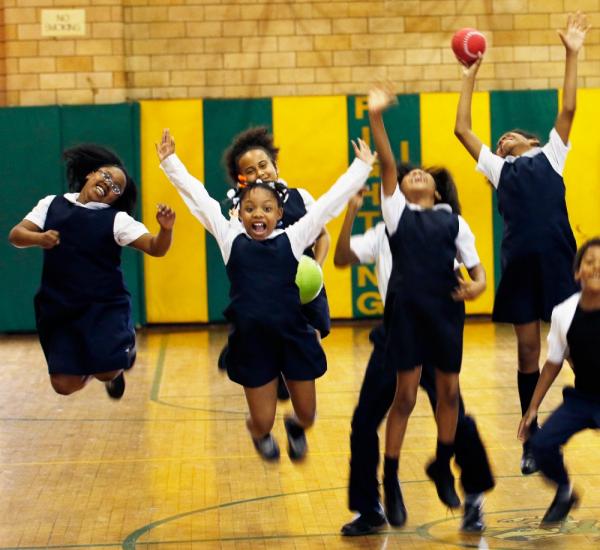December 7, 2018
Integrating Wellness into STEM Education
Jolene Gustafson, Director of The Connectory, National Girls Collaborative Project, highlights two STEM education programs making health and wellness a priority.
STEM and Wellness: Finding Intersections
Successful wellness resolutions require teamwork and collaboration. Healthier Generation's partnership with the National Girls Collaborative Project encourages educators to find intersections between STEM and wellness - a topic we're excited to explore together at the 2019 National Conference on Science Education.
Below, Jolene Gustafson, Director of The Connectory, National Girls Collaborative Project, highlights two STEM education programs making health and wellness a priority.
Ideas from the Field: 2 Stories
What is wellness? Ask 10 people and you’ll get 10 different answers. Many of those answers will include a nod to physical wellness, citing healthy eating and physical activity. There is, without a doubt, good reason to encourage both when working with youth. Kids who eat healthier and move more perform better at school. On this, the research is clear. But what about the other dimensions of wellness, such as social, emotional, and occupational?
Beyond Food and Activity
These other wellness factors can be as challenging when you are working with underrepresented and underserved youth. “When you unpack wellness, it’s about managing stress,” says Sylvia Aguiñaga, Tech & Tape Program Lead at 9 Dots in Los Angeles, California. “If you’re well fed and feel safe, you are able to do so much more. And if you don’t have those two main components of, well, humanness, you can’t function.”
9 Dots, which works with Title 1 elementary and middle schools and their students, partnered with a food bank for its summer computer coding camp. “Every student is fed a good meal,” Aguiñaga says. This is especially important during the summer for kids who rely on school meals. In addition, addressing social and emotional wellness factors is part of 9 Dots’ work. “We tackle that by providing a very safe environment,” Aguiñaga continues. “Beyond our safety procedures, we offer a warm and welcoming space to learn. We create a community, with staff greeting students each day, and getting to know what makes them, them.”
Skills That Need to Be Learned
Even for most adults, healthy habits and practicing wellness are difficult. These skills need to be acquired. “One of the things I learned later in life is that how you treat your body is very much part of the formula for success,” says Michelle Gall, Executive Director and Founder of Digital Girl, Inc. in Brooklyn, New York. “What you eat and drink — and exercise — contribute to your mental health and physical health. It’s why we try to incorporate wellness into everything we do.”
For Digital Girl, Inc. that means adding healthy snacks and movement into their STEM programming. “We do it without making a big deal of it, so students think of it as normal,” Gall says. “It’s all about balance. We have them ‘stretch it out’ to help calm down. We also talk about mental health a lot without saying it – having a positive outlook about themselves, envisioning themselves, even the language they use. Not ‘I can’t” but ‘I will try’ or ‘I am learning.’” This sort of language models persistence and the embracing of challenges, which will help kids develop a growth mindset – a great foundation for success.
In her role at 9 Dots, Aguiñaga trains adults in community organizations to teach coding and robotics. “Adults need to be fed well, too!” But offering healthy food is just the start. “We leave brain food facts near our snack table during training and work mindfulness exercises into our sessions.” The goal is to incentivize wellness for the adults, as well as offer information they can share with the kids they teach.
Wellness Is Core to Success
For programs that target underrepresented and underserved youth, like Digital Girl, Inc. and 9 Dots, the goal is to help even the playing field. STEM skills and experiences open up opportunities and can lead to more challenging and rewarding careers.
“It wasn't until I landed my first job that I really understood the opportunities that working in the tech space could afford,” Gall says of her career in digital marketing media. “It changed my life. Economically and in terms of career advancement, I didn’t think I could achieve so quickly. I also discovered that there were not a lot of people who looked like me.” Gall founded Digital Girl, Inc. in November 2014. With the help of Toni Robinson — a family friend and a software engineer who later become President of Digital Girl, Inc.’s Board — the two have embarked on a mission to enlighten young girls and inner-city youth to the benefits of pursuing such careers.
By building wellness into their programs, both 9 Dots and Digital Girl, Inc. are making it easier for the youth they serve to learn and achieve right now. They’re also giving them tools to succeed in life, not just at a STEM job.
- - -
Digital Girl, Inc. and 9 Dots are both part of The Connectory. Visit www.theconnectory.org to find camps, workshops, and other K-12 STEM opportunities near you. Program providers can join the free directory to use Partner Search and to list STEM opportunities for youth.


